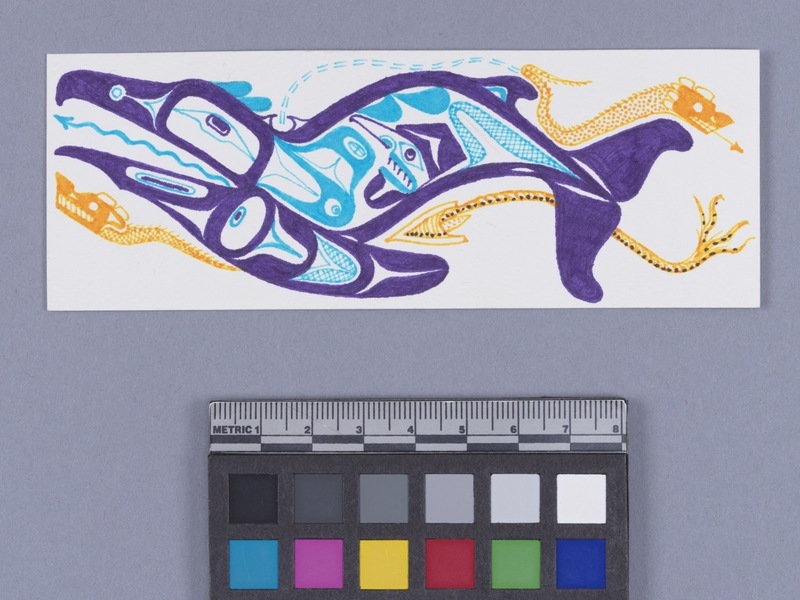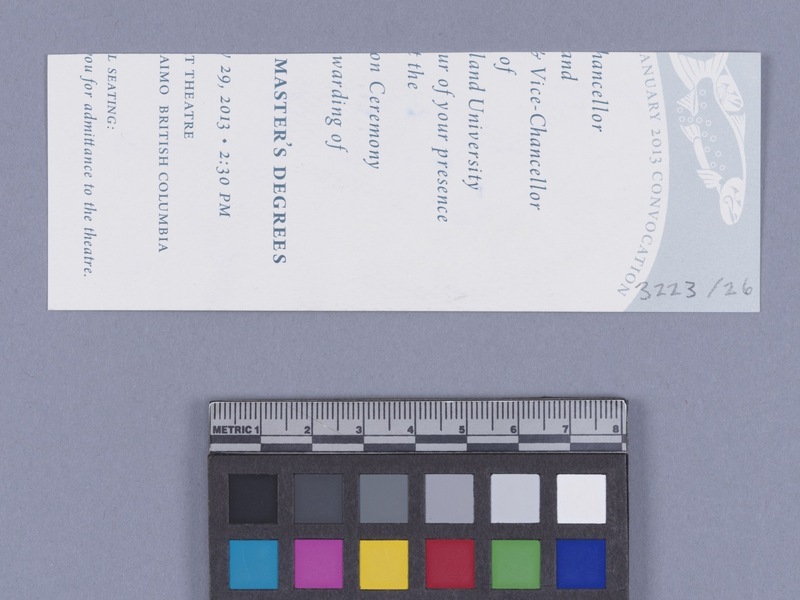Drawing Item Number: 3223/26 from the MOA: University of British Columbia


Description
A drawing on part of a white ticket from a convocation ceremony. The front-side is a vertically oriented, hand-drawn image of a killer whale and two lightning serpents(?). The outline of the whale is drawn in dark blue ink; the interior of the whale is decorated with light and dark blue shapes. A light blue arrow extends from the whale's mouth. Air, drawn as light blue dashes, exit from the blowhole at the back of the whale's head. Both serpents are drawn in orange ink. One is positioned under the whale's jaw, swimming with the whale, and the other is above the whale's tail swimming away from the whale. A harpoon tip(?), drawn in orange and dark blue ink, is positioned near the underbelly of the whale. On the reverse-side of the ticket, a fish graphic and text is printed in light blue-grey ink on a white background.
History Of Use
These 62 small works (3223/1-62) comprise a collection of drawings in pencil, ink, pencil crayon, and felt pen made by the artist between the years 1968 and 2015. During that period the artist has identified himself by the following names: Ron Hamilton; Hupquatchew; Ki-ke-in; Kwayatsapalth; Chuuchkamalthnii; and Haa’yuups. The drawings are, for the most part, applied to the backs of bookmarks acquired from a range of bookshops; some are applied to other pieces of paper or cutouts from his earlier silkscreen prints. Many of the images represent killer whales, often in conjunction with accoutrements and symbols of Nuu-chah-nulth whaling. The juxtaposition of bookmark and representation of Nuu-chah-nulth himwits’a, or narrative, is a deliberate and meaningful placement of two distinct knowledge systems in relationship with one another. Ephemeral drawings like these were not created for the market; the artist has long made them for himself and sometimes as gifts for relatives and friends; they are a way of sharing his knowledge and experience about Nuu-chah-nulth ways of knowing, thinking about, and being in this world; they are expressive of what he calls kiitskiitsa: marks made with intention.
Item History
- Made by Ron Hamilton (Maker) in British Columbia, Canada between 1968 and 2015
- Owned by Ron Hamilton before November 8, 2016
- Received from Museum of Anthropology Acquisitions Budget (Funding source), Michael O'Brian Family Foundation (Funding source) and Ron Hamilton (Seller) on November 18, 2016
What
- Name
- Drawing
- Identification Number
- 3223/26
- Type of Item
- drawing
- Overall
- height 5.0 cm, width 14.0 cm
Who
- Culture
- Nuu-chah-nulth: Hupacasath
- Creator
- Ron Hamilton (Maker)
- Previous Owner
- Ron Hamilton
- Received from
- Museum of Anthropology Acquisitions Budget (Funding source), Michael O'Brian Family Foundation (Funding source) and Ron Hamilton (Seller)
Where
- Holding Institution
- MOA: University of British Columbia
- Made in
- British Columbia, Canada
When
- Creation Date
- between 1968 and 2015
- Ownership Date
- before November 8, 2016
- Acquisition Date
- on November 18, 2016
Other
- Item Classes
- works on paper
- Condition
- excellent
- Accession Number
- 3223/0026